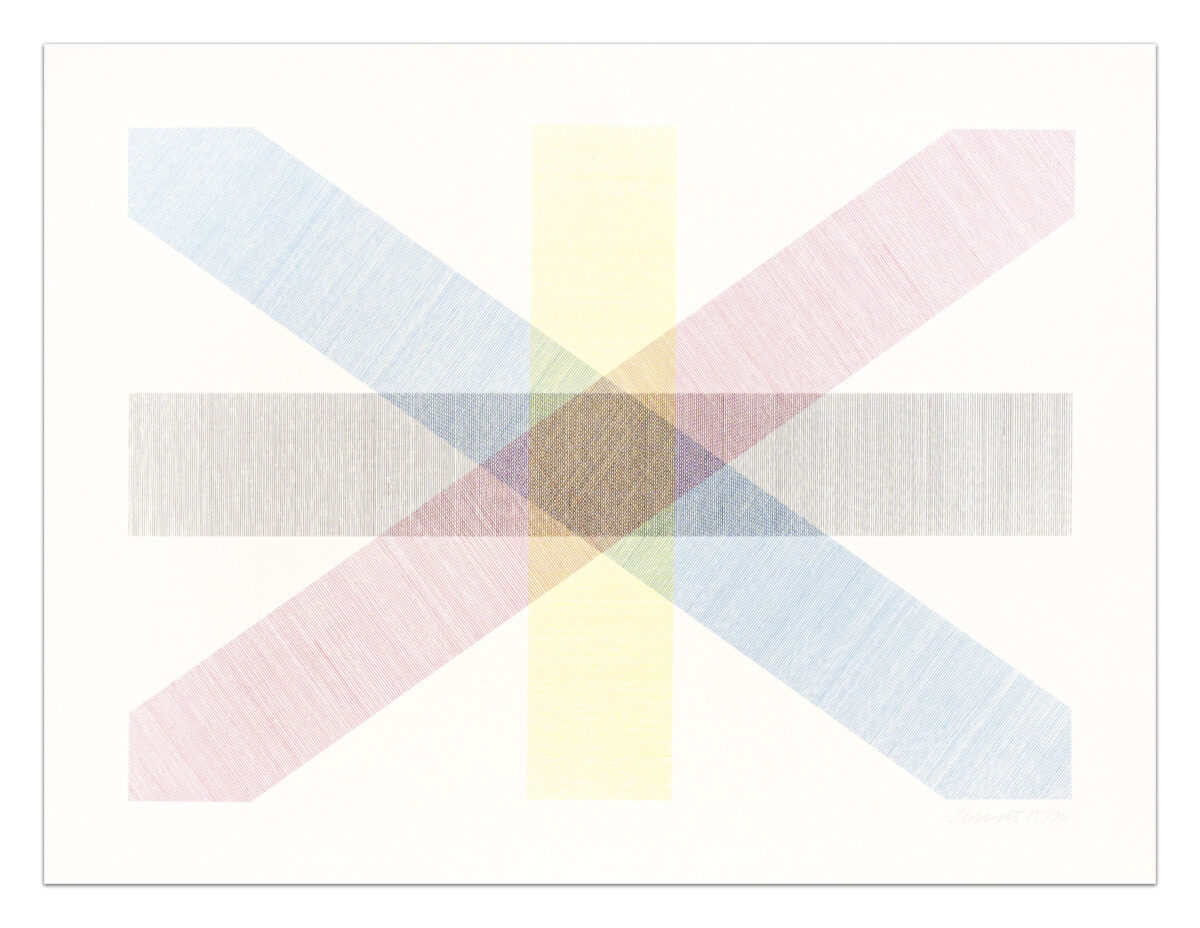
Image size: 11 3/4 x 16 3/8 inches (29.8 x 41.6 cm)
Paper size: 14 3/4 x 19 3/8 inches (37.5 x 49.2 cm)
Edition of 70
Signed and numbered lower right in graphite
(Inventory #30494)
Image size: 11 3/4 x 16 3/8 inches (29.8 x 41.6 cm)
Paper size: 14 3/4 x 19 3/8 inches (37.5 x 49.2 cm)
Edition of 70
Signed and numbered lower right in graphite
(Inventory #30494)
Sol LeWitt was born on September 9th, 1928 in Hartford, Connecticut to Eastern European immigrants. His father, a doctor and inventor, died when he was 6. Soon after, he moved with his mother, a nurse, to live with an aunt in New Britain, Connecticut. His mother took him to art classes at the Wadsworth Atheneum in Hartford and he would draw on wrapping paper from his aunt’s grocery store.
LeWitt received a BFA from Syracuse University in 1949 (where he made his first prints) and then was drafted in the Korean War in 1951. During his service, he made posters for the Special Services and spent time in Japan, where he bought the first works that became the basis of a large personal art collection.
In 1953, he moved to New York City, where he studied at the Cartoonists and Illustrators School (now the School of Visual Arts) and worked for Seventeen Magazine, making paste-ups, mechanicals and Photostats. He was then hired as a graphic designer in I.M. Pei’s architecture firm.
In 1960, he took an entry-level job at the Museum of Modern Art, where he met Dan Flavin, Robert Ryman, Lucy Lippard and Robert Mangold. Together, through the Sixteen Americans exhibition, they were introduced to the work of Jasper Johns and Frank Stella and Robert Rauschenberg.
LeWitt was also interested in Russian Constructivism, with its engineering aesthetic and the idea of making utilitarian art in an industrialized age. However, the work that influenced him the most was Eadweard Muybridge’s serial photography, sequential studies of people and animals in motion, which he came across in a book that somebody had left in his apartment. LeWitt’s work from the early 1960s, works on canvas coated with thick gestural oil paint, each featured one of Muybridge’s figures in motion.
LeWitt’s three dimensional structural works from the mid to late 1960s such as Serial Project, Three Part Variations on Three Different Cubes, and hundreds of sculptures made of open white cubes – grew out of this interest in the serial. He applied the same system of permutations and variations in his prints, drawings on paper and drawings on the wall.
Sol LeWitt executed his first wall drawing in 1968 at Paula Cooper Gallery in New York. Like many of the wall drawings after this, Wall Drawing #1 consisted of a system of parallel lines drawn with black pencil on a white wall in four directions (vertical, horizontal, diagonal left, and diagonal right.) By drawing directly on the wall, the work’s duration was limited and ultimately the wall drawings are painted over. It also allowed him to achieve his objective of reinforcing flatness and making a work as two-dimensional as possible. Wall Drawing #1 also emphasized the premise of the artwork over the final product. In a 1969 article for Studio International, LeWitt wrote, Two-dimensional works are not seen as objects. The work is a manifestation of an idea. It is an idea and not an object. Without the traditional support of canvas or paper, wall drawings exist as a set of instructions and can be installed again and again.
This radical shift to drawing on the wall, followed the publication of Paragraphs on Conceptual Art, where he wrote, “When an artist uses a conceptual form of art, it means that all the planning and decisions are made beforehand and the execution is a perfunctory affair. The idea becomes the machine that makes the art.”
Although LeWitt drew Wall Drawing #1 on Paula Cooper’s gallery wall himself, he soon found that a team of assistants could oftentimes install his work better. He believed that the idea of his work superseded the art itself, as curator Andrea Miller-Keller said, “The essence of LeWitt’s work is the original idea as formulated in the artist’s mind.” He soon took this and applied it to the print medium through numerous projects with numerous techniques.
In the late 70s, shortly after his first retrospective the at Museum of Modern Art and after numerous years of exhibiting in Italy, LeWitt moved to Spoleto, Italy. There he saw frescos by Fillippo Lippi, Massaccio, Fra Angelico and Giotto’s in local churches, museums and convents. In 1983, LeWitt’s art underwent a major transformation and he began to experiment with India ink and color ink washes, a nod to the local Trecento and Quattrocento works. He acknowledged the influence of these masterpieces on his own drawings, and went so far to say, that in his work he strived to produce something [he] would not be ashamed to show Giotto.”
In the exhibition catalogue for Think with Senses Feel with Mind, Art in the Present, part of the 2007 Venice Biennale, Robert Storr wrote that LeWitt proved over and over again that the strict, systematic realization of a singular working premise is bound to produce results that will surprise both the maker and the viewer by exceeding expectation and giving eye-and-mind expanding physical dimensions to mental abstractions. Until 2033, LeWitt’s wall drawings are the subject of a solo exhibition titled Sol LeWitt: A Wall Drawing Retrospective at the Massachusetts Museum of Contemporary Art.
Sol LeWitt died in 2007 in New York City.
10 Newbury Street, Boston, Massachusetts 02116
617-262-4490 | info@krakowwitkingallery.com
The gallery is free and open to the public Tuesday – Saturday, 10am – 5:30pm